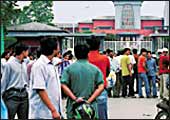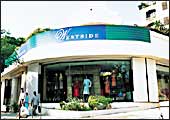 |
|
INDIVIDUAL STRENGTHS
|
|
Accenture: Has the broadest
pool of domain expertise and presence outside of India
TCS: Carries out the
most complex packaged applications work
Wipro: Has the broadest
set of value added services
Infosys: Has the deepest
pool of modern language talent
EDS: Present in the largest
number of geographies
IBM: Fully redundant
world class network infrastructure
|
It's official. Indian IT services
vendors have better global delivery capabilities than their overseas
counterparts. Global tech research firm Forrester has passed that
verdict in a research report titled Low-Cost Global Delivery Model
(GDM) Showdown, published earlier this month. The report places
Indian vendors TCS, Wipro and Infosys a few decisive notches above
IBM, EDS and Accenture, on offshore capabilities (see BT 60 Minutes
on Page 96).
All three Indian vendors appear in the "Leaders" category
of a detailed Forrester 'Wave' diagram on offshore capabilities
(TCS just about makes it into this category), while the overseas
vendors all lag behind in the "Strong Performers" category.
Infosys and Wipro vie for the top slot in the leader category, while
TCS just about makes it into the 'leader' segment. US-based software
services vendor EDS is plotted last in the strong performer category.
"In November 2002, we had talked of it services adopting
a tiered delivery model. Now this report is about how it is going
to evolve. There are two different camps leading this development,
onshore (US-based) and offshore vendors (Indian); the whole idea
here was to look at where they are in that evolution. It is not
meant to be an exact vendor to vendor analysis," explains John
McCarthy, the Forrester researcher who is the lead author of the
report.
The study evaluates the players on over 60 parameters to measure
a firm's low-cost GDM skills. The skills stretch across current
offerings, strategic direction and market presence. The focus is
largely on application-related work, which comprises the bulk of
client work on a low-cost GDM. "Third party validation of this
kind always helps when we talk to clients" says Sangita Singh,
Chief Marketing Officer, Wipro Technologies. "The most important
thing about the report is that it helps us bring a standard nomenclature
to GDM," she says.
The study makes interesting observations on the time budget variance
between the two sets of players. Like this one: "One reference
stated that the typical time and budget variance with IBM was 20
per cent, it dropped to less than 1 per cent when the application
work was shifted to Infosys.''
The Indian firms win hands down on the number of clients doing
applications maintenance, new development, packaged apps maintenance
and number of dedicated offshore development centres (see Individual
Strengths). "We are still in the early or middle stages of
the GDM development and each set of vendors have their challenges.
In this set of criteria, this is the way they graded out,"
says McCarthy.
The report obviously hasn't gone down well with the laggards.
"We think the report is too India-centric and we also sign
much larger contracts than the Indian vendors whereas the report
has only taken into account number of contracts," points out
Cathy Meister, Marketing head for Applications Services at global
it Services giant, EDS. Defends McCarthy: "When we spoke to
clients we found that 80 percent of the work they were sending offshore
was to India and also we don't have the calibre of vendors that
we see in India in any of the other offshore destinations."
The race to the finish has clearly begun. The question is: Will
the Indian vendors be able to maintain the lead when their overseas
rivals put all their investment capacity behind GDM? "Well
we are all climbing the mountain from different sides in a bid to
make it to the top" says Singh, before adding a trifle philosophically:
"Let's just say the wheel is spinning; we will have to wait
and see where it stops".
-Priya Srinivasan
The Mid-segment Bulge
Manufacturers slash prices to spur sales of
mid-sized cars.
It
would not take an expert to tell you that the car market in India
is booming. With over 700,000 passenger cars sold in 2003, the evidence
is clear and present on Indian roads. And even though the bulk of
the trade is still dominated by the 'compact', or B, segment, which
has over 60 per cent of the market (April-June 2004-05), another
segment that has got the manufacturers salivating is the mid-size,
or C, segment, and particularly the lower-end of this segment.
As car-makers hit the pedal, blame the smell
of burning rubber on Tata Motors and its B-stretched-to-C car, the
Indigo. Rolled out in early 2003, the Indigo was aggressively priced
below the Rs 5 lakh mark (and soft interest rates meant an EMI of
less than Rs 10,000) and today is the highest selling car in the
entire segment-in July alone 3,296 Indigos were sold. That has made
competitors sit up. In the past three months, Maruti Suzuki, General
Motors and Ford Motor have slashed prices of their own cars in the
segment. Take a look at the prices of the base models. The new-look
Esteem is cheaper by Rs 40,000 at Rs 4.25 lakh (ex-showroom, Delhi).
Ford has pushed the price of its Ikon down to Rs 4.49 lakh, a drop
of Rs 30,000 and General Motors' Corsa now costs Rs 4.86 lakh, which
is Rs 36,000 less than before.
Of course, none of the auto-makers will admit
that it's a reaction to Indigo, but they are more than willing to
admit that the price cuts are targeted at the million-plus compact
car owners in the country. "There are over a million people
out there with compact cars over two years old who are looking to
upgrade, and even if we can get a tenth of that number to shift
this year, we will almost double the segment", says David Friedman,
Managing Director, Ford India. The mid-size segment which grew at
over 30 per cent last fiscal, has seen sales for the first four
months of this fiscal climb by 31 per cent. Ford predicts that the
segment will grow to at least 140,000 units for the Calendar Year.
Maruti is already gaining. Price cuts have boosted Esteem sales
from an average of 1,000 a month to more than 1,700 in July.
However, the optimism is not shared by all.
Rajiv Dube, Vice President, passenger car division, Tata Motors,
believes that India is yet to acquire a high vehicle turnover rate.
"Just because some people in urban areas are upgrading frequently
does not make it a nation-wide trend." His rivals will soon
find out just how deep the new niche is.
-Kushan Mitra
EXIT
Uneasy in Kathmandu
 |
| Tough times ahead: Businesses are tentative
in Nepal |
Just 15 days ago, dabur Nepal sponsored
the Miss Nepal contest. Now, though, officials of the Indian company
(one of the 84 in Nepal) are preparing to pack their bags. Greenhouse
operations (Dabur Nepal is into food processing) have been suspended
for 10 days while the officials watch the moves of Maoist rebels,
who've not just taken on Nepal's government headed by Sher Bahadur
Deuba, but have issued "notices" to foreign businesses
to bankroll their insurgency. "We are very concerned about
our employees all of whom are Nepalese," says Sunil Gupta,
VP, Coca-Cola, whose Bottlers Nepal has suspended operations due
to growing violence. "We have been assured that Indian businesses
in Nepal will be protected," says Navtej Sarna, a spokesperson
for the Ministry of External Affairs. Incidentally, the largest
private sector employer in Nepal is itc's Surya Nepal. Meanwhile,
both consumers and companies suffer as prices of consumer products
soar.
-Amanpreet Singh
A
Market Gone Hyper
The who's who of corporate India is blueprinting
forays into hypermarkets.
 |
| Retail Rush: This one is a departmental
store; wait for the hypermarket |
For some time now, the stress has
been more on the hype and less on the market. That's beginning to
change, what with a clutch of corporate majors evaluating forays
into the hypermarkets space. According to the buzz in the market,
the Godrej group, the Mittals of the Bharti group, the Singhanias
of Raymond, Piramal Enterprises, ITC, the Munjals of the Hero Group,
the Tatas through Trent, the Wadias of Bombay Dyeing and the Reliance
Group are planning retail ventures, many of them in the hypermarket
format. Existing players like RPG Retail and Shopper's Stop, in
the meanwhile, are in a frenetic expansion mode. Raghu Pillai, CEO
(Retail Sector), RPG Enterprises, proffers one good reason for the
corporate rush into hypermarkets. ''Many hypermarkets are able to
achieve cash break-even within six to nine months.''
To be sure, many of the corporates blueprinting hypermarket forays
have already dabbled in retail in some manner: The Singhanias, for
instance, have their Plug-in stores, and a move into larger-format
retailing doesn't defy logic. Trent, which currently has a nationwide
chain of Westside lifestyle stores, will have at least one hypermarket
store towards the end of the year, reveal industry observers. And
a Godrej company official lets on that "the group is evaluating
the option of getting into retail," but the business model
has yet to be frozen.
Similarly, the Munjals of the Hero group plan to set up convenience
retail stores on the lines of global chain 7-Eleven. Rahul Munjal,
CEO, Easybill, the Munjal group firm that's spearheading the retail
thrust, points out that, like 7-Eleven, his company will also tie
up with companies and banks.
Arvind Singhal, Chairman, KSA Technopak, a Delhi-based retail
consultancy, has little doubt about the huge opportunity up for
grabs. The durables industry is worth Rs 45,000-50,000 crore, and
growing at 20 per cent conservatively, he says. The food and groceries
business is worth upwards of Rs 6,00,000 crore per annum. ''(Against
this), the biggest player in food retailing-Foodworld-is no bigger
than Rs 400 crore,'' says Singhal.
The landscape will change soon enough. The RPG group, which has
four retailing formats, is expanding in a big way. Within the next
three years, there will be 150 Foodworlds (up from 92 now), over
330 Music World stores (166), 140 Health and Glow stores (27) and
15 Giant stores (two), which could all move to the Spencer's brand
name. RPG Retail's Pillai is hopeful that the Giant hypermarkets
will post a turnover of Rs 250 crore this year and within the next
three years cross Rs 1,000 crore. ''Retail is a virgin territory,"
he says. Not for long, Mr Pillai.
-Swati Prasad
|
